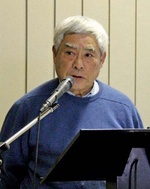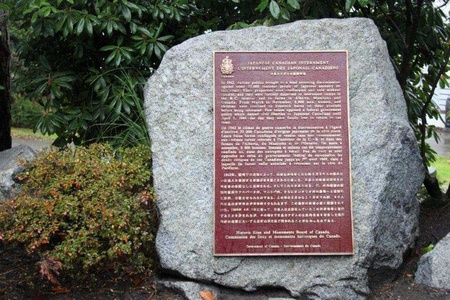“Over 3,000 Japanese Canadian women and children, demonstrating resilience under deplorable conditions, were unjustly detained here from March to December 1942. A public facility since 1929, the Livestock Building gained national historic significance as a federally authorized wartime marshalling site for Japanese Canadians prior to dispersal and internment. The detention, internment, confiscation of property, and expulsion from the coast of 22,000 innocent Japanese Canadians from 1942 to 1949 was officially acknowledged as unjust by Canada in 1988. In commemoration of all Japanese Canadians Interned. Gaman (Endurance) Giri (Duty) Ganbare (Perseverance),” inscribed on Vancouver Heritage Foundation (VHF). Plaque located at the Pacific National Exhibition site.

Keiko Mary Kitagawa of Delta, B.C. stands in front of Livestock Plaque, marking the infamous Vancouver locations where 3,000 Japanese Canadians were rounded up and housed before being sent on to interior British Columbia prison camps.
On December 1, 2012, a VHF plaque was unveiled at the infamous Livestock Building at the Pacific National Exhibition site where over 3,000 Japanese Canadian women and children were unjustly detained from March to December 1942.
A public facility since 1929, the Livestock Building gained national historic significance as a federally authorized wartime marshalling site for Japanese Canadians prior to that community’s forced removal from the 100 Mile Coastal Exclusion Zone of the Pacific coast and imprisonment in interior British Columbia prison camps for the duration of World War Two.
In 1988, Canada’s federal government admitted the injustice of its policies against Canadians of Japanese descent that caused the JC’s community’s “disenfranchisement, detention, internment, confiscation and sale of private and community property, expulsion, deportation, and restriction of movement which continued after the war,” and “were influenced by discriminatory attitudes. Japanese Canadians who were interned had their property liquidated and the proceeds of the sale were used to pay for their internment.” From the official Redress Acknowledgement signed by Prime Minister Brian Mulroney,September 22, 1988.

Tosh Kitagawa reading a message from NAJC president Ken Noma at the Vancouver unveiling event on December 1, 2012.
The following is a speech written by National Association of Japanese Canadians (NAJC) president Ken Noma and presented on that occasion by Vancouver NAJC member Tosh Kitagawa:
“Dear Honoured Guests, Friends and the many representatives of local and government organizations whose support of the Hastings Park Project made the refurbishment and relocation of the plaques possible.
I bring you warm greetings from the 14 member organizations that constitute the National Association of Japanese Canadians.
Hastings Park is hallowed ground.
With us today are the spirits of thousands of Nikkei who were detained, some for over a year in 1942 prior to their dispersal to internment camps and other facilities. If we close our eyes for a moment, we might feel their suffering, hear the cries of babies, and see the look of confusion and expressions of anger and shame on the adults’ faces.
Lives were in disarray and many dreams dashed. The crowded and unsanitary conditions, further amplified these feelings. Japanese Canadians had been abandoned by their own government. We honour their suffering and pay tribute to the determination of our elders who, after the expulsion, struggled to rebuild their lives.
At great personal sacrifices, they succeeded in creating a better future for their children. We come here today to proclaim that—although small in number—our roots continue to dig deep in this country after 135 years.
Hastings Park is an important benchmark in the history of Canada.

Hastings Park Committee (left to right) Jean Kamimura, Walt Kamimura, Jessica Quan Of Vancouver Heritage Foundation Places That Matter Project, Donna Nakamoto, Mary Kitagawa, Lorene Oikawa, Judy Hanazawa, Kate Huffman of Pacific National Exhibition, Beth Carter, Tosh Kitagawa. (Missing are: Dan Tokawa, Leslie Komori, Rika Uto of the Vancouver Japanese Language School, Kristen Lambertson of Powell Street Festival, Kaz Takahara of the Vancouver Japanese Gardeners Association, David Iwaasa of Tonari Gumi, and Greater Vancouver Japanese Canadian Citizens Association representatives: Shag Ando, and Human Rights Committee member Morgan Elander.)
It is timely that this event is being held on the last month of 2012—the 70th anniversary of the imposition of the government’s internment policy. The ceremony today is an important act of reconciliation and heralds the 25th anniversary of the Redress Settlement between the Government of Canada and the National Association of Japanese Canadians which will be next year.
Let us take the opportunity today to remind all Canadians of the fragility of our civil rights and the need to be forever vigilant.
Thank You!”
© 2013 Norm Ibuki






